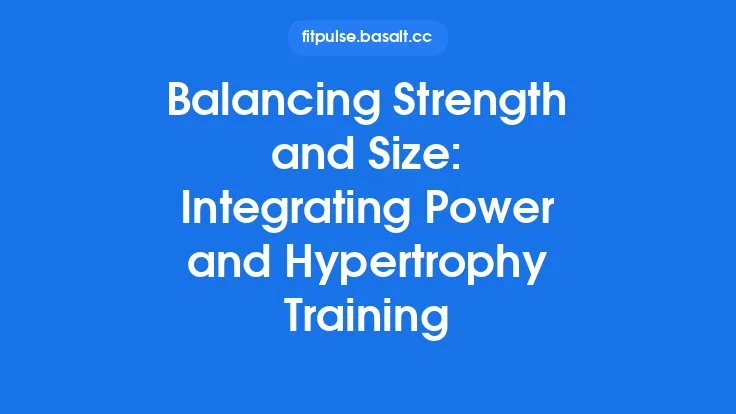Integrating strength training with skill work is one of the most nuanced challenges faced by combat athletes. While the art of striking, grappling, or weapon handling demands precise motor patterns, timing, and situational awareness, the science of strength development pushes the body toward greater force production, structural resilience, and, in many cases, increased muscle mass. When these two domains clash, the result can be a loss of speed, reduced range of motion, or a plateau in technical proficiency. Conversely, when they are deliberately woven together, the athlete gains a powerful synergy: stronger muscles that move more efficiently, and refined techniques that capitalize on that newfound strength. The following guide explores how to balance hypertrophy and technique without sacrificing the core attributes that define a successful martial artist.
Understanding the Dual Demands of Combat Sports
Combat disciplines are inherently hybrid. A fighter must generate explosive force (e.g., a punch or takedown), sustain repeated high‑intensity efforts, and execute complex movement patterns under fatigue. From a physiological standpoint, this translates into three primary demands:
| Demand | Primary Adaptation | Typical Training Focus |
|---|---|---|
| Force Production | Increased maximal strength and rate of force development (RFD) | Heavy compound lifts, unilateral presses, loaded carries |
| Technical Precision | Refined neural pathways for specific motor patterns | Repetitive skill drills, sparring, scenario training |
| Weight Management | Maintaining optimal body mass for the athlete’s weight class | Nutrition, body composition monitoring (outside scope) |
The key is to recognize that these demands are not mutually exclusive; rather, they intersect at the neuromuscular level. A well‑programmed strength stimulus can reinforce the neural pathways used in technique, while skill work can improve the recruitment patterns needed for efficient strength expression.
The Science of Concurrent Training: Hypertrophy Meets Skill Acquisition
Concurrent training refers to the simultaneous development of strength (or hypertrophy) and an endurance‑type skill. In combat sports, the “endurance” component is largely technical rather than aerobic. Research shows that when strength and skill sessions are appropriately spaced, interference—where one stimulus blunts the adaptation of the other—can be minimized.
Key mechanisms to consider:
- Molecular Signaling: Resistance training activates the mTOR pathway, promoting protein synthesis and muscle growth. Skill practice, especially at high speeds, stimulates the AMPK pathway, which can antagonize mTOR if the two stimuli overlap excessively. Temporal separation (e.g., 6–8 hours) reduces this antagonism.
- Neural Adaptations: Both strength and skill work rely on motor unit recruitment, but they emphasize different aspects. Strength training enhances maximal recruitment and firing frequency, while skill work refines inter‑muscular coordination. When scheduled correctly, the nervous system can integrate both adaptations without “confusion.”
- Hormonal Environment: Acute spikes in testosterone and growth hormone after heavy lifting can create a favorable anabolic window for subsequent skill practice, provided the athlete is not overly fatigued.
Designing a Balanced Weekly Blueprint
A practical framework begins with a macro‑cycle that defines the overall emphasis (e.g., “strength‑focused” vs. “technique‑focused”) and then breaks down into micro‑cycles (weekly plans). Below is a generic template for a 5‑day training week, assuming the athlete trains twice daily (morning and evening sessions). Adjustments can be made for single‑session days or competition phases.
| Day | Morning (Strength) | Evening (Skill) |
|---|---|---|
| Monday | Upper‑body hypertrophy (3‑4 sets × 8‑12 reps) – bench press, rows, overhead press | Striking fundamentals – pad work, footwork |
| Tuesday | Lower‑body strength (4‑5 sets × 4‑6 reps) – squat, deadlift variations | Grappling flow drills – positional transitions |
| Wednesday | Active recovery / light mobility (non‑strength) | Technical sparring – controlled intensity |
| Thursday | Upper‑body power (5 sets × 3 reps) – push press, weighted pull‑ups | Mixed‑modal drills – striking‑to‑takedown combos |
| Friday | Lower‑body hypertrophy (3‑4 sets × 8‑12 reps) – split squat, Romanian deadlift | End‑round conditioning – high‑intensity interval skill rounds |
| Saturday | Optional supplemental work (e.g., grip, posterior chain) | Open‑mat sparring or competition simulation |
| Sunday | Full rest | Full rest |
Guidelines for the blueprint:
- Separate high‑intensity strength and skill sessions by at least 6 hours to allow hormonal and neural recovery.
- Rotate emphasis (upper vs. lower, hypertrophy vs. power) to prevent chronic fatigue in any single movement pattern.
- Include at least one “skill‑only” day (Wednesday) to allow the nervous system to consolidate technique without the added load of heavy lifting.
Prioritizing Exercise Selection for Technique Support
Not all strength exercises translate equally to combat performance. The goal is to choose lifts that reinforce the movement planes, joint angles, and force vectors used in the specific martial art.
| Movement Goal | Recommended Exercise | Rationale |
|---|---|---|
| Horizontal pushing/pulling (e.g., jab, cross, clinch control) | Bench press, weighted push‑ups, bent‑over rows, inverted rows | Directly trains the shoulder‑elbow extension/flexion used in striking and grappling frames. |
| Vertical power (e.g., high kicks, jumping clinches) | Overhead press, push press, dumbbell snatch | Develops shoulder and hip extension through a vertical plane, mirroring kick and takedown mechanics. |
| Rotational strength (e.g., hook punches, torso twists) | Landmine rotations, cable woodchops, single‑arm kettlebell press | Enhances transverse‑plane torque essential for delivering rotational force. |
| Hip drive & posterior chain (e.g., hip‑explosive kicks, sprawls) | Deadlift variations, hip thrusts, glute‑ham raises | Strengthens the glutes and hamstrings, the primary drivers of hip extension. |
| Unilateral stability (e.g., stance shifts, single‑leg grappling) | Bulgarian split squat, single‑leg Romanian deadlift, pistol squat progressions | Improves balance and force transfer when the athlete is on one leg or in a staggered stance. |
| Grip & forearm endurance (e.g., clinch control, gi grips) | Farmer’s walk, plate pinches, towel pull‑ups | Reinforces the hand‑to‑forearm chain without isolating the forearm to the point of fatigue. |
Implementation tip: Pair each primary lift with a “skill‑specific” accessory that mimics the range of motion of a key technique. For example, after a set of deadlifts, perform 5‑10 slow, controlled hip‑extension kicks to reinforce the neural pattern of hip drive.
Managing Volume and Intensity to Preserve Skill Fidelity
Hypertrophy protocols typically involve moderate loads (70‑85 % 1RM) and higher volume, which can generate significant muscular fatigue. To protect technical performance:
- Cap total weekly volume for any given muscle group at 12‑15 sets. Exceeding this can lead to lingering soreness that interferes with precise movement execution.
- Use “auto‑regulation” tools such as RPE (Rate of Perceived Exertion) or velocity‑based training (VBT) to adjust loads on the fly. If an athlete reports an RPE > 8 on a strength day, consider dropping the load by 5‑10 % for the subsequent skill session.
- Employ “cluster sets” for power‑oriented lifts (e.g., 3 × (3 + 3 + 3) reps with 20‑second intra‑set rest). This maintains high bar speed while limiting metabolic fatigue.
- Schedule “deload weeks” every 4‑6 weeks, reducing volume by 30‑40 % while maintaining intensity. This preserves strength gains and allows technique to consolidate.
Sequencing Strength and Skill Sessions for Optimal Transfer
The order in which strength and skill work are performed can dramatically affect the quality of each session.
| Sequence | When to Use | Expected Benefits |
|---|---|---|
| Strength → Skill (e.g., heavy lift in the morning, technique in the evening) | During “strength‑focused” phases or when the athlete needs to reinforce power output in technique | Acute hormonal surge supports neural plasticity; skill work benefits from fresh, primed motor units. |
| Skill → Strength (e.g., technique first, then light strength) | During “technique‑focused” phases, pre‑competition weeks, or when the athlete is fatigued from heavy lifting | Skill performance is not compromised by pre‑exhaustion; strength session can be kept at lower intensity to avoid overreaching. |
| Integrated “Hybrid” Sessions (e.g., a circuit of kettlebell swings followed by a drill) | When time constraints exist or for “maintenance” weeks | Provides simultaneous stimulus, but careful monitoring is required to avoid excessive systemic fatigue. |
Practical rule of thumb: If the primary goal of the week is to increase maximal strength, schedule the heavy lifts first. If the goal is to sharpen technique for an upcoming bout, place skill work first and keep strength work sub‑maximal.
Monitoring Adaptation and Adjusting on the Fly
Objective data helps prevent the dreaded “strength‑technique trade‑off.” Consider the following monitoring tools:
- Performance Logs: Record load, sets, reps, and RPE for each strength session; note perceived technical quality (e.g., “clean jab,” “smooth transition”) after each skill session.
- Movement Screens: Conduct a brief biomechanical check (e.g., squat depth, shoulder mobility) weekly to detect compensations that could affect technique.
- Force Plate or Push‑Band Metrics: Track peak force and rate of force development during a standardized lift; compare to baseline to gauge neuromuscular readiness.
- Heart‑Rate Variability (HRV): While not a primary focus, HRV can flag systemic stress that may impair fine motor learning.
When trends indicate declining technical quality (e.g., increased errors in footwork) while strength metrics remain stable, consider reducing hypertrophy volume or shifting to a more power‑oriented strength emphasis for the next micro‑cycle.
Common Pitfalls and How to Avoid Them
| Pitfall | Why It Happens | Mitigation Strategy |
|---|---|---|
| “Bulking” at the expense of speed | Excessive caloric surplus + high‑volume hypertrophy | Limit hypertrophy sets to 8‑12 weeks, then transition to strength/power phases; monitor body composition. |
| Training the same muscle group on consecutive days | Overlap of compound lifts (e.g., bench press + push‑ups) with skill drills that heavily involve those muscles | Use a “push‑pull‑legs” split or rotate focus so that a muscle group gets at least 48 hours of relative rest. |
| Neglecting unilateral work | Overreliance on bilateral barbell lifts | Incorporate at least one unilateral exercise per major lift day. |
| Sporadic session timing | Inconsistent spacing between strength and skill sessions | Set a fixed schedule (e.g., strength at 08:00, skill at 16:00) and stick to it for at least 4 weeks before adjusting. |
| Ignoring fatigue cues | Relying solely on planned loads without listening to the athlete’s feedback | Implement daily RPE checks; if RPE > 8 on two consecutive days, schedule a light or technique‑only day. |
Case Study: A Sample 8‑Week Integration Plan
Athlete Profile: 27‑year‑old mixed‑martial‑arts competitor, competing at 77 kg, aims to increase striking power without sacrificing speed.
| Week | Focus | Strength Protocol | Skill Emphasis |
|---|---|---|---|
| 1‑2 | Baseline hypertrophy | Upper‑body 4 × 10 (70 % 1RM) – bench, rows; Lower‑body 3 × 12 (65 % 1RM) – split squat, RDL | Technical drilling – 3 × 3‑minute rounds, focus on jab‑cross combos |
| 3‑4 | Transition to strength | Upper‑body 5 × 5 (85 % 1RM) – bench, weighted pull‑ups; Lower‑body 4 × 5 (80 % 1RM) – front squat, deadlift | Power striking – 2 × 5‑minute rounds, integrate weighted mitt work |
| 5‑6 | Power & speed | Upper‑body 6 × 3 (90 % 1RM) – push press, speed rows (3 × 3 sec rest); Lower‑body 5 × 3 (85 % 1RM) – jump squats, kettlebell swings | High‑intensity combos – 4 × 3‑minute rounds, focus on rapid entry/exit |
| 7‑8 | Peaking & taper | Strength volume reduced 40 %; focus on single‑digit reps at 80 % 1RM; add plyometric accessories (box jumps) | Fight‑simulation sparring – 5 × 5‑minute rounds, full‑intensity |
Key observations:
- Hypertrophy phase builds a muscular foundation without excessive bulk.
- Strength phase introduces higher loads, improving maximal force.
- Power phase translates that force into faster, more explosive technique.
- The final taper preserves strength while allowing the nervous system to recover for competition.
Final Thoughts: Sustainable Integration for Long‑Term Success
Balancing hypertrophy and technique is less about “choosing one over the other” and more about orchestrating two complementary systems. By:
- Understanding the physiological interplay between strength signaling and skill learning,
- Structuring weekly and monthly plans that respect recovery windows,
- Selecting exercises that mirror combat movement patterns,
- Managing volume, intensity, and sequencing to protect technical fidelity, and
- Continuously monitoring performance to make data‑driven adjustments,
the martial artist can enjoy the benefits of increased muscular capacity while preserving, or even enhancing, the precision and fluidity that define elite combat performance. The result is a fighter who not only hits harder and controls positions more effectively but also moves with the speed, timing, and adaptability required to succeed in the ever‑evolving arena of combat sports.





